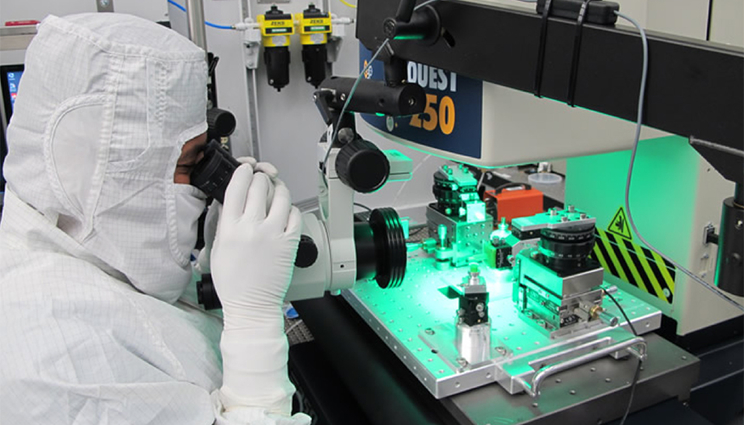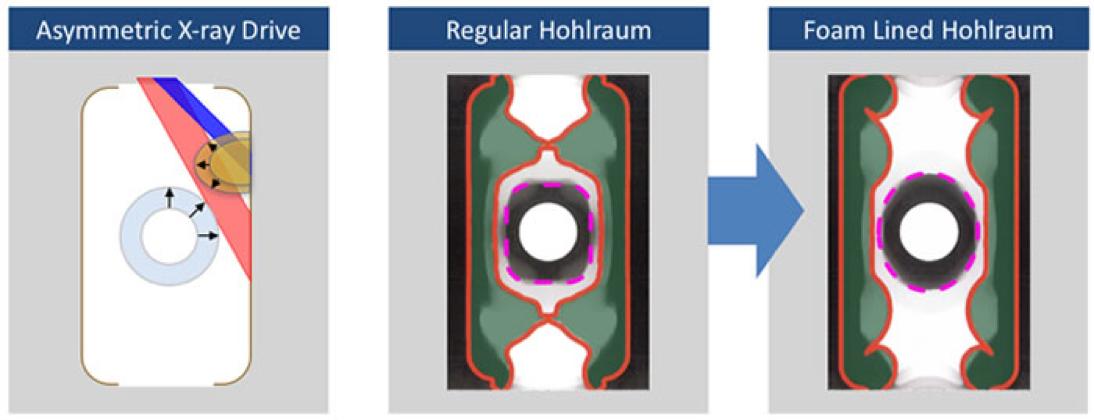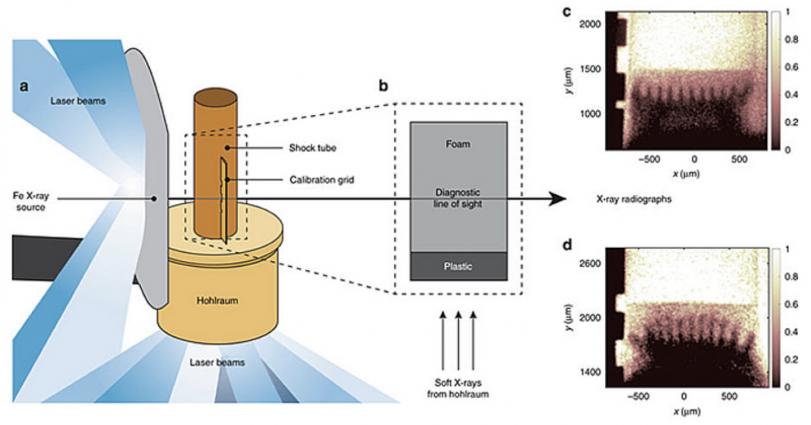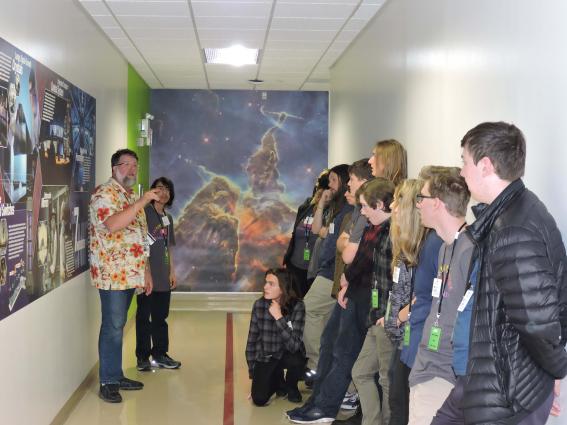The softer side of NIF hohlraums
 (Download Image)
Ricardo Heredia of the Target Fabrication Engineering Team at Lawrence Livermore National Laboratory works on the assembly of a foam-lined hohlraum system into a cryogenic target.
(Download Image)
Ricardo Heredia of the Target Fabrication Engineering Team at Lawrence Livermore National Laboratory works on the assembly of a foam-lined hohlraum system into a cryogenic target.
Considering that nothing precious comes from an online retailer without protective padding, could precision laser targets also benefit from similar high-tech swaddling?
So far the answer is yes, for a group of scientists developing new target technologies for NIF that are intended to neutralize what they believe is one of the bigger challenges to achieving ignition.
The goal, said Lawrence Livermore National Laboratory (LLNL) physicist Cliff Thomas, is to use a low-density foam liner to limit hohlraum wall motion — the problematic physics that come with forcing nearly two megajoules of energy into the hohlraum in a few billionths of a second (see "How NIF Targets Work"). If the density of the foam is low enough — some 100 times lighter than conventional metals like aluminum — having a well-behaved hohlraum could be just around the corner.
Thomas leads the team developing the design of the new, highly specialized foam liners, while Suhas Bhandarkar leads the target fabrication development in a collaboration between LLNL and General Atomics (GA) that integrates experts in target design, target fabrication and materials science.
"The foams we can make are almost magic," said Thomas, "but we need more practice at using them." Thomas, a former intern who joined the Lab full time in 2007, works in the Design Physics Division of the Weapons Complex and Integration Directorate.
"Our first tests have been promising," Thomas said. Ultimately, the goal of the project is to increase the energy coupled to the hohlraum and target capsule and increase the fusion yield that can be achieved at NIF.
The problem
The hohlraum is a tiny gold canister mounted in a complex target assembly at the center of the NIF Target Chamber. Its purpose is to capture laser light, convert it to X-rays and use those X-rays to compress and heat a small capsule filled with hydrogen.
When NIF’s powerful lasers are directed at the hohlraum, its walls tend to collapse. "Essentially," Thomas explained, " the middle of the hohlraum fills with gold, and this keeps the laser from getting to where it needs to be." By lining the hohlraum with padding, like the new specialized foams being developed at LLNL, the researchers hope to reduce wall motion and design targets that use the laser much more efficiently.
In concept, lining the core of the hohlraum sounds smart. But Thomas’ team needs foam liners thin enough to fit into the hohlraum and strong enough to not flake apart. They also need the foam to be uniform, so the laser can pass through without scattering from small imperfections.
‘Magic’ solutions
Many of the foams so admired by Thomas are being produced by a team led by Ted Baumann, a chemist who is group leader of Advanced Materials in the Physical and Life Sciences Directorate.
The first generation of foams used to test the hohlraum liner concept are made of tantalum oxide (Ta2O5). Baumann’s team utilizes a technique known as sol-gel chemistry to prepare the foams. "Basically, it works a lot like chemistry you can try in your kitchen," Baumann said. "We dissolve the building blocks for the tantalum oxide foam in a liquid, much like you would with gelatin in making Jell-O."
With care, these building blocks assemble to form a three-dimensional network. When the liquid is removed using a special process called supercritical drying, it leaves behind a tantalum oxide sponge, or foam, that typically is 100 times less dense than solid materials.
Baumann has spent more than 20 years developing materials to support Lab missions, but the hohlraum foams, "superhero" strong yet almost cloudlike in their lightness, have been a challenge. With recent advances, his group can make foams that are even lighter — almost as light as air — and so delicate they can’t be touched directly.
The task of leading the target fabrication effort for turning these "magic" hohlraum physics concepts into reality falls to Bhandarkar, an engineer in the Laboratory’s Materials Science Division. "It is an exciting challenge," Bhandarkar said, "and we see it as one of the important stepping stones in our quest for ignition."
While Bhandarkar’s team is testing the tantalum-oxide foams, it’s also experimenting with alternative foam materials developed both at LLNL and at GA. Each has its advantages in target design, and constraints on target fabrication ultimately could determine which is best.
To transform the foams into actual liners, seven different approaches being developed by many experts in diverse technical fields are being beta-tested. So far, the most successful involves shaping the foam to the desired dimension through the use of laser-cutter technology pioneered by Noel Alfonso at GA. Foam liners also are being built piece-by-piece on a three-dimensional printer, which at LLNL is affectionately called "the Lego brick approach."
Micron-level (millionth of a meter) precision is required. The parts must be small enough to fit into a hohlraum — smaller than a fingernail — and have edges that are close to perfect. The foams also need to hold their shape and satisfy strict requirements on their makeup throughout the many steps involved in doing a shot at NIF.
The Lab has considerable expertise working with foams and ultra-low-density aerogels, sometimes known as "frozen smoke." Still, it has taken these new technologies to get to the point where a foam-lined hohlraum is a real possibility. With the help of the steady electronic hands of robotics, the team can make identical strips of the delicate foam.
The collaboration for developing protective padding for NIF targets has involved contributions from additional LLNL personnel including Kevin Baker, Alastair Moore, Monika Biener and Thomas "Mike" Reese. Laboratory scientists working on alternate techniques include Tyler Fears, James Oakdale, Sergei Kucheyev, Juergen Biener, Corey Horwood and Tom Bunn. Lab partners at GA in foam-lining work include Jarrod Williams, Hannah Reynolds and Fred Elsner.
The research and development in foam-lining technology has shown substantial potential, Thomas said, and he believes it is starting to change how researchers think about target design.
"If you want to take a big step forward," he said, "then you typically need something else — a new set of tools — and foams are one of the technologies we think can really push the boundaries of what is possible."
--Lisa Petrillo
Contact
 Breanna Bishop
Breanna Bishop
[email protected]
(925) 423-9802
Related Links
“How NIF Targets Work"General Atomics
Tags
National Ignition Facility and Photon ScienceNational Ignition Facility
Lasers and Optical S&T
Laser Materials
Lasers
Physical and Life Sciences
Featured Articles










